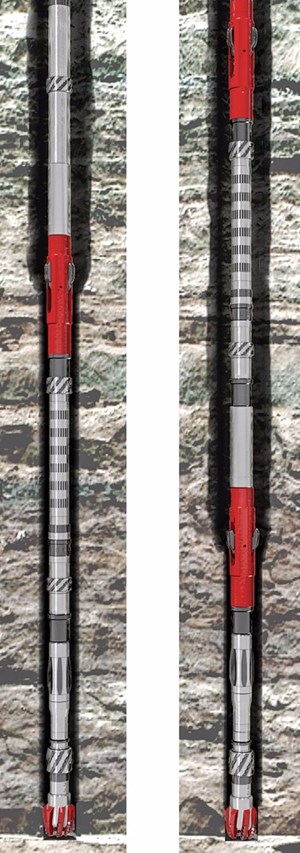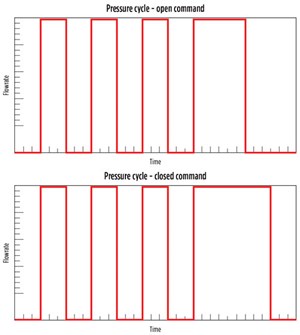A major international oil company, working in remote, harsh conditions, and drilling world-class extended-reach wells, recently called on Weatherford to solve a difficult underreaming-while-drilling challenge.
Weatherford applied unique tools and skills to meet the challenge, allowing for the well objectives to be met, and saving the operator a significant amount of rig time. This solution is now base business for this ongoing extended-reach well project.
OBJECTIVE
For these wells, the design of the gravel pack completions requires an 81/2-in. x 91/2-in. hole to be drilled/underreammed below 95/8-in., 47-ppf casing. Further, the completion design requires that the non-underreamed, 81/2-in. rathole be kept to an absolute minimum—just a few meters.
Conventional underreamers that have been used historically for this application are not able to be placed deep enough in the BHA to meet well objectives, because actuation balls or darts cannot pass through the required LWD/MWD equipment.
As such, the operator was forced in the past to make a round trip at TD, to change out the BHA, to underream the bottom few meters of the well. This additional trip was costly, added complexity to the operation, and increased crew safety risk incrementally by lengthening the time spent building the well.
SOLUTION
Upon being approached by the operator, Weatherford deployed its Riptide underreamer and personnel to operate these tools. The underreamer’s unique RFID-based design allows for placement virtually anywhere in the BHA, including below LWD screens. This, in turn, allows the operator to drill and underream the pay interval with a single BHA, saving rig time, reducing well complexity, and incrementally improving crew safety.
The details of this solution, now executed successfully in four of these ERD wells, are described in detail below. This solution is now base business for this operator in this world class operation.
Hole-enlargement limitations. These ERD wells utilize measurement-while-drilling/logging-while-drilling (MWD/LWD) tools and a rotary-steerable system (RSS) in the drillstring. The conventional underreamers used previously were activated by mechanically pumping darts or balls into the tool from surface. As such, this previous setup required the underreamer to be placed above the MWD/LWD—far up the BHA, leaving a significant amount of non-underreammed, 8-1/2-in. hole. For the first well in which this operator employed Riptide, this un-enlarged hole would have been 180 ft (61 m), far too much to allow for the needed completion design.
Using conventional underreamers, the only option available to remove this rathole would be to pull the drillstring out of the hole and then execute a second, dedicated underreamer run. This adds days of rig time to the operation; requires more tool handling for the crew on the rig floor; increases the time that the borehole is exposed, and incrementally increases crew safety risks by increasing the time required to build the well.

DEVELOPING AN INTELLIGENT ALTERNATIVE
The operator called upon the service company to deploy a HEWD solution that would clean out, and enlarge, nearly all of the lower section of the wellbore, thereby meeting the completion objectives of the well. After closely analyzing the BHA, the service provider proposed an intelligent underreamer solution that would place two underreamers on the same drillstring.
Specifically, the solution involved placing a RipTide RFID underreamer in an “upper position,” that is above the MWD system, some 242 ft above the drill bit, Fig. 1. This upper RipTide reamer is activated by deploying RFID tags to enlarge the majority of the wellbore during the drilling operation. This RFID communication approach ensured that the underreamer would not compromise the MWD/LWD capabilities or interfere with surface communication.
Once the bit reached TD, the upper underreamer was deactivated by dropping a second set of RFID tags. A second “deep position” underreamer (known as the RipTide Rathole Killer) was positioned below the MWD system, only 27 ft above the drill bit. This allowed enlargement of the deep portion of the wellbore and thereby shortened the length of the rathole section.
This lower underreamer can be activated by one of two methods, depending on the type of MWD system deployed on the BHA. If the MWD is battery-powered, then a sufficiently large ID opening exists to allow an RFID tag to pass through, unobstructed, and activate the lower reamer. To date, field experience has shown no interference between the RFID signal and the operation of, or communication between, the MWD and RSS assemblies.
In this particular case, the operator wanted to try both methods of activation, to verify the effectiveness of each. The lower underreamer was activated by pumping down RFID tags, and then using the alternative pressure cycle underreamer activation. As the result of this operation, the operator is now comfortable using either activation method, depending on the environment, BHA design and other factors.
Both the upper and lower underreamers can be activated and deactivated, independent of the other, on demand and multiple times. Deploying both reamers in the same BHA during the drilling run greatly increases operational efficiency by eliminating the need to trip out for a dedicated cleanout run. It also minimizes other carryover problems associated with longer open-hole times.
JOB EXECUTION DETAILS
With the proposed HEWD plan approved by the operator, service company technicians collaborated with the drilling crew to execute the operation. RFID and pressure-cycle function tests were conducted on the underreamers, prior to installing them into the BHA, Fig. 2. Following successful surface testing, the BHA was assembled to include an 8 ½-in. PDC bit, the RSS, the lower RFID underreamer, the MWD/LWD tools, and the upper RFID underreamer.
The well already had been drilled to the point where hole enlargement would be required. The drillstring and BHA were run in-hole to a measured depth (MD) of approximately 11,000 ft. The BHA then drilled the shoe track, and a successful formation integrity test was conducted. Following the successful test, new hole was drilled to an MD near 11,300 ft, which placed the upper reamer just below the 95/8-in. casing shoe.
Nine RFID tags programmed with an “open” command were pumped downhole simultaneously, and surface pressure measurements confirmed that the underreamer cutting blocks had activated. Drilling and simultaneous hole enlargement operations then proceeded, with the bit drilling an 81/2-in. hole, and the primary drilling reamer enlarging the hole to 91/2 in.

At an MD of approximately 11,700 ft, the RSS was no longer meeting the directional requirements for the well. This prompted the drilling crew to pump RFID tags to close the upper reamer and then pull the BHA out of hole to replace the RSS.
Visual inspection confirmed that the upper reamer had opened downhole, while the lower reamer had remained closed. The BHA was then run back in-hole with a new RSS. The upper reamer was opened by pumping “open-command” RFID tags, and HEWD operations continued.
The upper underreamer then enlarged the wellbore successfully to the required depth of 14,650 ft, as planned. The BHA was then picked up, off bottom, and RFID tags were pumped downhole to deactivate the upper reamer and lock the cutters in a closed position.
Eliminating the rathole. The drillstring was then pulled up, to position the lower underreamer to a point above the 81/2-in.-to-91/2-in. hole transition. Another set of RFID tags programmed with an “open” command (programmed to only affect the lower underreammer) was pumped downhole to activate the lower underreamer. The expected pressure drop observed at surface indicated that the tool had opened, and the BHA was lowered into position. The lower underreamer was then used to open the rathole to just a few meters above the TD of the well.
With the great majority of the rathole eliminated, the BHA was pulled approximately 2 m off bottom, and a series of RFID tags programmed with the “close” command was pumped downhole to deactivate (close) the lower underreamer. The operation avoided the need for a secondary reaming trip to eliminate the rathole.
With both underreamers closed, the driller then commenced backreaming out of the hole. The wellbore was cleaned efficiently during the backreaming operation, without any additional cuttings or induced vibrations generated by the underreamers.
Pressure-cycle trial. Once the BHA reached the 95/8-in. casing shoe, backreaming was suspended, and the lower underreamer underwent a pressure-cycle activation trial. With the lower reamer positioned approximately 13 ft below the casing shoe, the field technician initiated a pressure cycle to open the tool. The flowrate was increased to the drilling flowrate, and a drop in pressure recorded at surface indicated that the reamer blocks had activated successfully.
Following a 10-to-15 kips pull test against the casing shoe, the reamer was deactivated, using a pressure cycle. The test confirmed that, in the event RFID tags could not be deployed, pressure-cycle activation and deactivation could be performed reliably. The BHA was then pulled inside the 95/8-in. casing shoe, and further operations commenced.
Value delivered. Weatherford’s dual-reamer BHA solution helped the operator meet all directional drilling objectives and land in the target zone. The RFID-activated drilling reamer was integrated into the directional-drilling assembly without compromising logging performance or interfering with the RSS as it reduced the hole angle. On-demand RFID technology enabled the dual-reamer BHA to drill the 81/2-in. hole section to TD and enlarge it to 9½ in., while minimizing the rathole and cleaning the wellbore in a single trip.
Avoiding a dedicated cleanout trip not only enhanced safety by reducing rig operations, but it also saved significant rig time and costs. The operator estimated a savings of 50 hr of rig time, which translated to significant well costs.
INCORPORATING LESSONS LEARNED
The job also illustrated the operational flexibility enabled by having multiple methods of actuation available. The upper reamer was repeatedly, reliably actuated using RFID tags. To activate the second reamer, located below the BHA, both RFID and pressure-cycle activation proved successful. RFID tags are proven to pass through multiple turbines, restrictions and various BHA tools without issue. However, having pressure cycle available as a backup actuation method provides operators with additional flexibility and reassurance.
For its part, the operator has moved forward with deploying the dual underreamer option for all subsequent HEWD operations in the region. Other offshore operators are watching the runs closely, with an eye toward implementing this technology to save money and minimize risk while building out their own structurally complex wells. ![]()
- Driving MPD adoption with performance-enhancing technologies (January 2024)
- Rig electrification drives down emissions, bolsters efficiency while improving onshore drilling economics (October 2023)
- Wellbore seal control and monitoring enhance deepwater MPD operations (October 2023)
- Advancing casing drilling to deepwater: Rethinking top hole well construction (August 2023)
- Mobile electric microgrids address power demands of high-intensity fracing (July 2023)
- Utilizing electronic data captured at the bit improves PDC design and drilling performance (July 2023)


